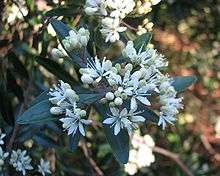Leionema elatius
Leionema elatius, commonly known as tall phebalium,[3] is a shrub species that is endemic to New South Wales and Queensland in Australia. It has glossy green variable shaped leaves and clusters of white-lemon flowers in spring.
| Leionema elatius | |
|---|---|
 | |
| Leionema elatius subsp. beckleri | |
| Scientific classification | |
| Kingdom: | Plantae |
| Clade: | Tracheophytes |
| Clade: | Angiosperms |
| Clade: | Eudicots |
| Clade: | Rosids |
| Order: | Sapindales |
| Family: | Rutaceae |
| Genus: | Leionema |
| Species: | L. elatius |
| Binomial name | |
| Leionema elatius | |
| Synonyms[2] | |
| |
Description
Leionema elatius is a shrub that grows to 2–5 m (6 ft 7 in–16 ft 5 in) high with either smooth stems or with star-shaped hairs. The leaves are flat, lance-shaped, oblong or narrowly oval to spoon-shaped, 1.5–3.5 cm (0.59–1.38 in) long, 3–10 mm (0.12–0.39 in) wide, upper surface shiny and smooth with a distinctive midrib below. The inflorescences are at the end of branches crowded by the leaves, pedicels and peduncles both slim. The calyx lobes are wide-triangular shaped and fleshy. The flower petals are white to light yellow, 3–4.5 mm (0.12–0.18 in) long and glandular. The fruit are about 4 mm (0.16 in) long and furrowed. Flowering occurs in spring.[3]
Taxonomy and naming
Leionema elatius was first formally described in 1998 by Paul G. Wilson and the description was published in Nuytsia.[4][5]The specific epithet (elatius) is derived from the Latin meaning "taller".[6]
Two subspecies are accepted by the Australian Plant Census:
- L. elatius subsp. beckleri is a shrub to about 2 m (6 ft 7 in) high, stems rough and glandular, with more or less lance shaped leaves, 1.5–2 cm (0.59–0.79 in) long, 3–5 mm (0.12–0.20 in) wide, apex blunt or rounded or occasionally slightly notched and the fruit slightly flattened. This subspecies has a restricted distribution in the McPherson Range Queensland and north east New South Wales.[5][7]
- L. elatius subsp. elatius is a shrub to 5 m (16 ft) high, leaves more or less lance to egg-shaped, 2–3.5 cm (0.79–1.38 in) long, 6–10 mm (0.24–0.39 in) wide, rounded apex slightly notched, mostly smooth stems, flower bud oval-shaped about 4 mm (0.16 in) long, fruit wide and angled from the stem. This subspecies grows in the ranges in north eastern New South Wales, north of Bulahdelah.[5][8]
Distribution and habitat
Leionema elatius grows mostly on the ranges north of Bulahdelah and far south-eastern areas of Queensland.[5]
References
- "Leionema elatius". Australian Plant Census. Retrieved 26 April 2020.
- "Leionema elatius ". Australian Plant Name Index (APNI), IBIS database. Centre for Plant Biodiversity Research, Australian Government, Canberra. Retrieved 2010-08-08.
- "Leionema elatius". PlantNET-NSW flora online. Royal Botanic Gardens Sydney. Retrieved 26 April 2020.
- "Leionema elatius". Australian Plant Name Index. Retrieved 26 April 2020.
- "Nuytsia". Biodiversity Heritage Library. Retrieved 26 April 2020.
- Francis Aubie Sharr (2019). Western Australian Plant Names and their Meanings. Kardinya, Western Australia: Four Gables Press. p. 190. ISBN 9780958034180.
- "Leionema elatius subsp. beckleri". Australian Plant Census. Retrieved 27 April 2020.
- "Leionema elatiussubsp.elatius". Australian Plant Census. Retrieved 27 April 2020.
External links
- "Leionema elatius (F.Muell.) Paul G.Wilson". Atlas of Living Australia.